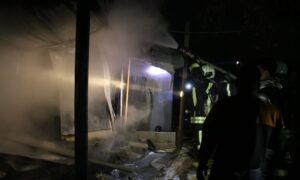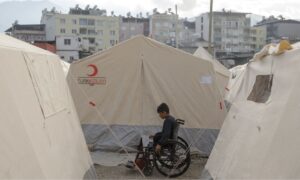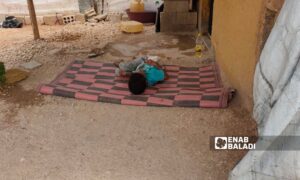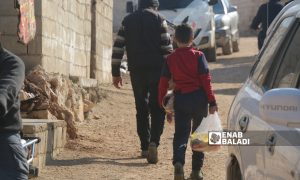New housing complex to accommodate most vulnerable IDPs in al-Bab city
On 7 November, after six months of construction work and preparation, a new housing complex, near al-Bab city, was inaugurated to house the most vulnerable families from the camps of al-Bab, Bazaa, and Qabasin in the northeastern countryside of Aleppo. The project, called al-Hilal Residential City, has 29 residential units providing 116 apartments. Each apartment consists of 3 rooms, a kitchen, and utilities, with an area of 46 square meters.
First phase
The project was the result of collective efforts from the Qatar Red Crescent Society (QRCS), Qatar Fund for Development (QFFD), Disaster and Emergency Management Presidency of Turkey (AFAD), Saed Charity Association (SCA) and the local council of al-Bab city.
Mohamed Salah Ibrahim, Executive Director of QRC Society, in an interview with Enab Baladi, said that the apartments were distributed to vulnerable IDPs carefully selected by the local council. Ibrahim said he hopes that the success of such cooperation between the specialized associations for the provision of assistance to Syrians will result in setting up similar projects in other parts of Syria.
The project coordinator at the QRCS, Ali Shawakh, explained that the opening of the residential units is considered the first stage in the project. An additional 92 similar residential units are planned for construction, adjacent to the first units.
The first stage took four months to be completed from 1 May until 31 August. Shawakh expected that the second stage of HRC is to be completed by the end of this year.
The location of the project was selected to be outside the city of al-Bab, “to avoid overcrowding,” according to the project coordinator, Abdulsalam Sweid in an interview with Enab Baladi.
The local council of the city allocated a publicly-owned land for the project, near the main road linking the cities of al-Bab and the al-Rai.
Beneficiary families
A beneficiary of the project, Bashir al-Bobo, was displaced from his home in Ghouta, ending up in camps in northern Syria, where he experienced severe hardships.
The apartments were equipped with windows, doors, ceramic tiles and electricity. Bashir saw his new apartment and noted the “big” difference between the tent and the apartment.
“We suffered from dust, rain and lack of water, and life was very difficult in the tent,” Bashir told Enab Baladi, referring to the diseases his children were suffering from due to the hard conditions of the tents.
The project coordinators selected the beneficiaries by an inventory of the situations of camp residents. They chose the most vulnerable and poorest from families with widows, orphans and people with special needs.
The project coordinator for QRCS, Ali Shawakh, told Enab Baladi that the beneficiaries will move to their new homes next week.
According to estimates by the UN office for the Coordination of Humanitarian Affairs (OCHA), northwestern Syria has 2 million displaced people (IDPs). 630,000, out of 4 million IDPs live in camps in the region. 2.7 million people are in need of humanitarian assistance.
if you think the article contain wrong information or you have additional details Send Correction
-
Follow us :
Most viewed
- Washington clarifies to Enab Baladi Assad's claims of secret meetings with US officials
- Russian raids around al-Tanf accompanied by accusations against Americans
- Al-Assad issues decree on establishing alternative information ministry
- After controversy over his fate, Ali Mamlouk appears in Russia
- US Senate approves “Captagon II” bill, paving way for presidential signature

















 A
A
A
A
A
A







 More LC & CSO
More LC & CSO